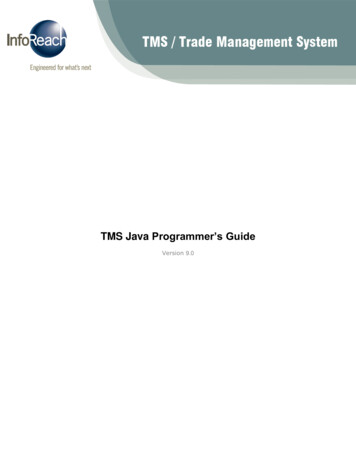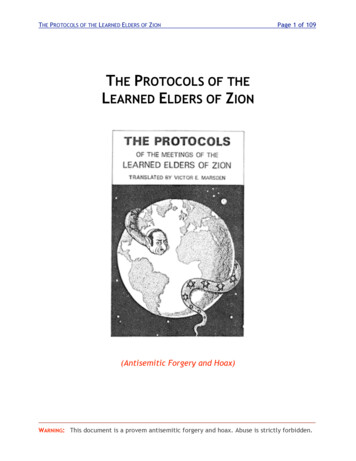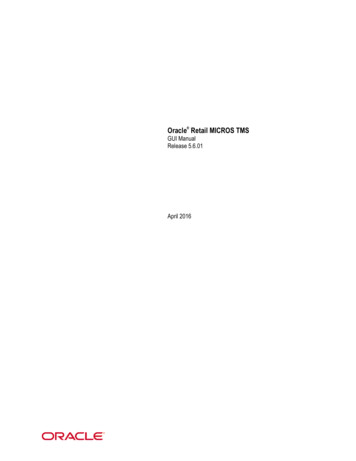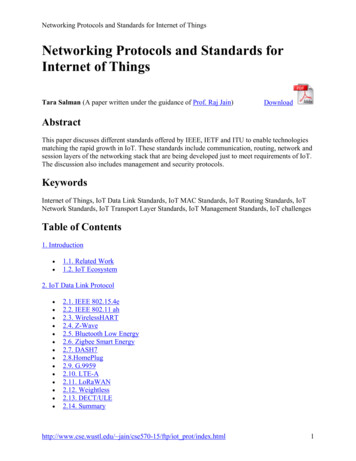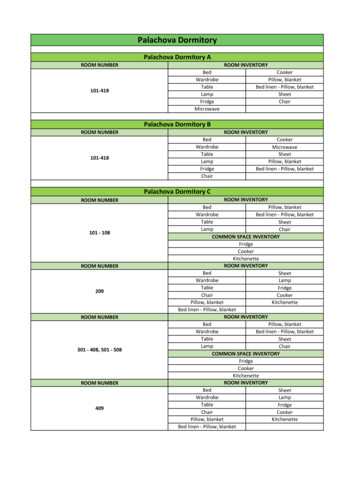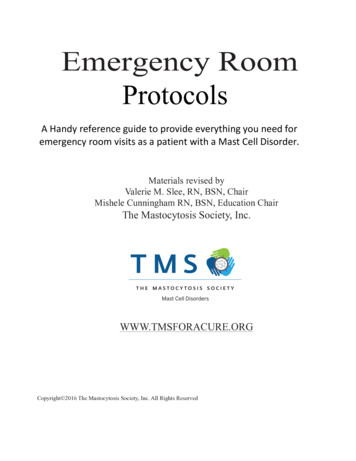
Transcription
Emergency RoomProtocolsA Handy reference guide to provide everything you need foremergency room visits as a patient with a Mast Cell Disorder.Materials revised byValerie M. Slee, RN, BSN, ChairMishele Cunningham RN, BSN, Education ChairThe Mastocytosis Society, Inc.WWW.TMSFORACURE.ORGCopyright 2016 The Mastocytosis Society, Inc. All Rights Reserved
The Mastocytosis Society, Inc.www.tmsforacure.orgEmergency Room ProtocolTable of Contents1.Personal Health History2.Emergency Response Plan Signed By Your Physician3.Lab Tests to be Drawn in ER (during mast cell degranulation event)4-7Medication by Indication8.Drug Allergies9.Physician Contact Information10.Drugs to Use and Avoid11.How to Contact TMS in an Emergency12.What to Say Upon Arriving in the ER - Short Scripts13.Additional Ways to Advocate for a Child in the ER14.What Should Medical Alert Jewelry Say?15.ReferencesCopyright 2016 The Mastocytosis Society, Inc. All Rights Reserved
The Mastocytosis Society, Inc.www.tmsforacure.orgPersonal Health History Form To Review with Primary Care Physician or SpecialistName:Date of Birth:Home Address:HeightWeight Range:Medic Alert Jewelry Phone NumberPhone Numbers: Home:Cell:WorkPrimary care physician name and address:In case of emergency, please contact (name and phone number):Current Diagnoses:Allergies:Medications:Physician Signature:Date:Copyright 2016 The Mastocytosis Society, Inc. All Rights ReservedPage 1
Emergency Room Response PlanPatient Name:DOB:DATE:If the patient presents with flushing, rash, hives, swelling, abdominal pain, nausea, vomiting,shortness of breath, wheezing or hypotension, respond:Administer Epinephrine 0.3 cc of 1/1000 and repeat 3x at 5-minute intervals if BP 90 systolic (0.1 ccfor children under 12) Benadryl (Generic: diphenhydramine) 25-50 mg (12.5-25 mg for children under 12) orally,intra-muscular or intravenously (slow IV push) every 2—4 hours or Atarax (Generic: hydroxyzine)25 mg (12.5 mg for children age 2-12) orally every 2—4 hours Solu-Medrol (Generic: methylprednisolone) 120 mg (40 mg for children under 12) IV/IM Oxygen by mask or nasal cannula 100% Albuterol nebulizationPre-medication for major and minor procedures and for radiology procedureswith and without dyes: Prednisone 50 mg orally (20 mg for children under 12) 24 hours and 1—2 hours prior to surgery/procedure Benadry1 (Generic: diphenhydramine) 25-50 mg orally (12.5 mg for children under 12) orAtarax (Generic: hydroxizine) 25 mg orally, 1 hour prior to surgery/procedure Zantac (Generic: ranitidine) 150 mg orally (20 mg for children under 12) 1 hour prior tosurgery/procedure Singulair (Generic: montelukast) 10 mg orally (5 mg for children under 12) 1 hour prior tosurgery/procedureDrugs to be avoided: Aspirin and non-steroidal anti-inflammatory medications Morphine, codeine derivatives VancomycinRecommend: TylenolAdditional Orders:Physician SignatureDateThe Mastocytosis Society thanks Dr. Mariana Castells for this emergency protocol.Copyright 2016 The Mastocytosis Society, Inc. All Rights ReservedPage 2
The Mastocytosis Society, Inc.Laboratory tests to run on patients in the Emergency Department who have had a mast cell degranulationevent.1. Serum Tryptase-upon arrival in the ER and three hours later. If hospital lab is outfitted with the immunocapsystem, serum tryptase results are obtained in 4 hours or less.2. 24 hour urines for:n-methyl histamineprostaglandin D2(PGD2) and11-beta prostaglandin F2 alpha3. Complete chemistry panel4. CBC with differentialYou MUST have your allergist or primary care provider sign the bottom of this form stating that he or shewill be responsible for the follow-up on the 24 hour urine collections. Otherwise, the ER physicians will bereluctant to order them since they cannot be sure of follow-up care. Remember to contact your physician forfollow-up after *******************I agree to provide follow-up care for my patient,.And will obtain the results of the 24 hour urine collections that were initiated in the emergency room setting,and will provide appropriate care based on the results.Printed Name of PhysicianSignature of PhysicianDateContact AddressPhone Number:Fax Number:Copyright 2016 The Mastocytosis Society, Inc. All Rights ReservedPage 3
The Mastocytosis Society, Inc.www.tmsforacure.orgMediCation List:Copyright 2016 The Mastocytosis Society, Inc. All Rights ReservedPage 4
MEDICATION BY INDICATION ORGANIZERMEDICATION LIST:Copyright 20 16 The Mastocytosis Society, Inc. All Rights ReservedPage 5
MEDICATION BY INDICATION 0RGANlZERMEDICATION LIST:MEDICATION LIST:OTHER ILLNESSESMEDICATION LIST:
MEDICATION BY INDICATION ORGANIZERMEDICATION LIST:MEDICATION LIST:MEDICATION LIST:MEDICATION LIST:MEDICATION LIST:
The Mastocytosis Society, Inc.www.tmsforacure.orgDRUG ALLERGY FORMDrug Brand NameDrug Generic NameType of Reactionto DrugHow Long AgoReaction Occurred
The Mastocytosis Societywww.tmsforacure.orgPhysicians ListPHYSICIAN’S SPECIALTY AREASPRIMARY CARE PROVIDER ! INTERNIST ! FAMILY PRACTITIONER ! PEDIATRICIAN ! ALLERGIST/IMMUNOLOGIST ! CARDIOLOGISTDENTIST ! DENTAL SPECIALIST ! DERMATOLOGIST ! EARS, NOSE, AND THROAT SPECIALIST ! ENDOCRINOLOGIST! GASTROENTEROLOGIST HEMATOLOGIST/ONCOLOGIST ! NEPHROLOGIST ! NEUROLOGIST ! NEUROSURGEON ! OPTHALMOLOGIST! ORTHOPEDIST ! PSYCHIATRIST PSYCHOLOGIST ! RHEUMATOLOGIST ! SURGEON-GENERAL ! SURGEON-PLASTIC ! UROLOGIST! DIETICIAN ! PHYSICAL THERAPIST OCCUPATIONAL THERAPIST ! OTHERPage ian’sEmail**EXAMPLE ONLY**Dr. SmithFamily Practitioner555 Physician's LaneNew York City, New mCopyright 2016 The Mastocytosis Society, Inc. All Rights Reserved
The Mastocytosis Society, Inc.www.tmsforacure.orgQUICK REFERENCE GUIDE: MEDICATIONS TO USE AND AVOIDIN PATIENTS WITH MAST CELL DISEASE IN EMERGENCY SITUATIONSPlease note: Some of the Drugs to Avoid may be given if absolutely necessary, if given with a prep tostabilize mast cells. Please refer to one of our mast cell experts for instructions.Medication TypeAVOID THESE DRUGSDrugs that are typically toleratedGeneral DrugsAlcoholAmphoteracin BAnticholinergic drugsDextranDextromethoraphanEthanolPolymyxin BQuinineVancomycin IVAlpha-adrenergic blockersBeta-adrenergic blockersPain MedicationsOpioid narcotics (may be tolerated bysome individuals)ToradolNon-steroidal anti-inflammatory drugs(unless the patient is already taking adrug from this class)Fentanyl (may require adjunct treatmentwith Zofran)TramadolMuscle Local ivacaineRopivacaineIntraoperative InductionMedsKetamineMidazolamPropofolInhaled AnestheticsSevofluraneReferences:1. DVDs from the TMS Annual Conferences, 2006, 2007, 2008, 2009, 2010, 2011, 2012, 20132. Mastocytosis: Perioperative Considerations. V.A. Goins.AORN Journal. December 1991: 54(6):1229-1238.3. Mastocytosis: Current Concepts in Diagnosis and Treatment.L. Escribano, C. Akin, M. Castells, A. Orfao, DD.Metcalfe, Annals of Hematology(2002); 81 677-690.4. REMA protocol for mastycotosisCopyright 2016 The Mastocytosis Society, Inc. All Rights ReservedPage 10
The Mastocytosis Society, Inc.www.tmsforacure.orgFor information about mastocytosis and mast cell related disorders, direct yourInternet browser to The Mastocytosis Society, Inc. Website:http:/www.tmsforacure.orgTo contact The Mastocytosis Society, Inc. Board of Directors, you can email:tmsbod@tmsforacure.orgTCopyright 2016 The Mastocytosis Society, Inc. All Rights ReservePage 11
What to say upon arriving in the Emergency RoomBRIEF SCRIPTS1. If your problem is a full blown mast cell attack/mast cell degranulation/fainting/anaphylaxis:I amyears old with a known systemic mast cell disorder, and I amhaving anaphylaxis. (Say this even if you have not experiencedanaphylaxis before as any mast cell degranulation attack can result infull blown anaphylaxis.)2. If your problem is something else, (virus, fracture, auto accident, etc) and your mast cells are alreadyflaring up:I amyears old with(i.e. an injury to my leftknee). I have a systemic mast cell disorder, and I am at high risk ofanaphyaxis. I need to be treated immediately to prevent that from happening.3. If you have cutaneous disease but have systemic symptoms from the mast cell mediatorsreleased from your skin lesions:I amyears old and I have cutaneous mastocytosis with systemiceffects from the release of mediators in my skin lesions. I am at highrisk for anaphylaxis and need to be treated immediately to prevent that.Copyright 2016 The Mastocytosis Society, Inc. All Rights ReservedPage 12
The Mastocytosis Society, Inc.www.tmsforacure.orgAdditional ways to advocate for a child in the Emergency Room1. Offer the copy of The Special Edition of The Mastocytosis Chronicles for Health CareProfessionals, and refer to the page on Pediatric Mastocytosis.2. Explain that mast cells in cutaneous lesions release mediators that result in systemicsymptoms, sometimes severe, such as flushing, nausea, vomiting, diarrhea, headaches,itching, difficulty concentrating, dizziness, etc. (add your child’s symptoms here.)3. Explain clearly how your child manifests early signs of deterioration or anaphylaxis,especially if it is not a typical presentation: Does your child develop hives or swelling around the face, mouth or eyes, or developflushing or pallor? Does your child get an itchy, red rash (other than hives)? Does your child develop a cough, especially one that can be staccato in nature in younger children, or maymimic their asthma cough Does your child develop frequent sneezing and/or a runny nose? Does your child exhibit shortness of breath? Does your child complain of chest pain even in the absence of shortness of breath? Does your child complain of a mouth or tongue that feels funny? (Note: this mayhappen well before any visible oral swelling can be recognized or appreciated on exam). Does your child exhibit hoarseness or a change in voice? Does your child clear his or her voice repetitively? Does your child complain of trouble swallowing, or appear to be drooling excessively? Does your child exhibit sudden abdominal pain? Does your child develop nausea? vomiting? In some children, this may be the onlyinitial symptom. Does your child feel anxious, or tell you that something awful is happening?You know your child best, so be sure to educate the ER about how to recognize early anaphylaxis in your child.4. Make sure that all medications and IV additives are alcohol free.Copyright 2016 The Mastocytosis Society, Inc. All Rights ReservedPage 13
Medic Alert and other JewelryWhen deciding what to put on your medical jewelry, the first word should always be:1.Anaphylaxis!2. Systemic mastocytosis or systemic mast cell disorder or mast cell activation syndrome.3. If, and only if, you are on a Beta blocker, add the following:On Beta blockers-give glucagon with Epinephrine.4.Drug Allergies: if you have 1 allergy, then list it. If you have multiple then state “drug allergies”.5.Food Allergies: if you have 1 food allergy, then list it. If you have multiple then state“multiple food allergies”.6.Latex Allergy7.Drug, food and latex allergies can be combined.8.Next add other illnesses: diabetes, angina, thyroiditis, etc.Copyright 2016 The Mastocytosis Society, Inc. All Rights ReservedPage 14
References:1.Anaphylaxis. Mayo Foundation for Medical Education and Research, 1998-2010, February 2009.2.What You Should Know About Anaphylaxis. American Academy of Allergy, Asthma and Immunology.February 2009.3.Akin C, editor. Mast Cells and Mastocytosis. Immunol Allergy Clin North Am. Philadelphia:Elsevier; 2006 Aug; 26(3):465-476, 487-504, 515-529, 541, 549-566.4.Akin C, et al. Mast cell activation syndrome: proposed diagnostic criteria. J Allergy Clin Immunol.2010 Dec;126(6):1099-104 e4.5.Castells M, editor. Anaphylaxis and Hypersensitivity Reactions. New York: Humana Press; 2011.6.Gotlib J. On being metachromatic: mystique and misunderstanding in mastocytosis. Am J Hematol.2009 Dec;84(12):779-81.7.Hamilton MJ, et al. Mast cell activation syndrome: a newly recognized disorder with systemicclinical manifestations. J Allergy Clin Immunol. 2011 Jul;128(1):147-52 e2.8.Lieberman P, et al. The diagnosis and management of anaphylaxis practice parameter: 2010 update.J Allergy Clin Immunol. 2010 Sep;126(3):477-80 e1-42.9.Norred CL. Anesthetic-induced anaphylaxis. J Am Assoc Nurse Anesth. 2012 Apr;80(2):129-40.10.Simons FE, et al. World Allergy Organization anaphylaxis guidelines: summary. J Allergy ClinImmunol. 2011 Mar;127(3):587-93 e1-22.11.Kounis NG, et al. Kounis syndrome: a new twist on an old disease. Future Cardiol. 2011Nov;7(6):805-24.12.Lanier, BQ. Anaphylaxis Update. ACEP Now. 2013 Mar;Retrieved from ns FE, et al. World Allergy Organization Anaphylaxis Guidelines: 2013 update of the evidencebase. Int Arch Allergy Immunol. 2013;162(3):193-204.14.Hernandez-Trujillo V, Simons FE. Prospective evaluation of an anaphylaxis education mini-handout: the AAAAI Anaphylaxis Wallet Card. J Allergy Clin Immunol Pract. 2013 Mar;1(2):181-5.Page 15
Page 15 References: 1. Anaphylaxis. Mayo Foundation for Medical Education and Research, 1998-2010,

